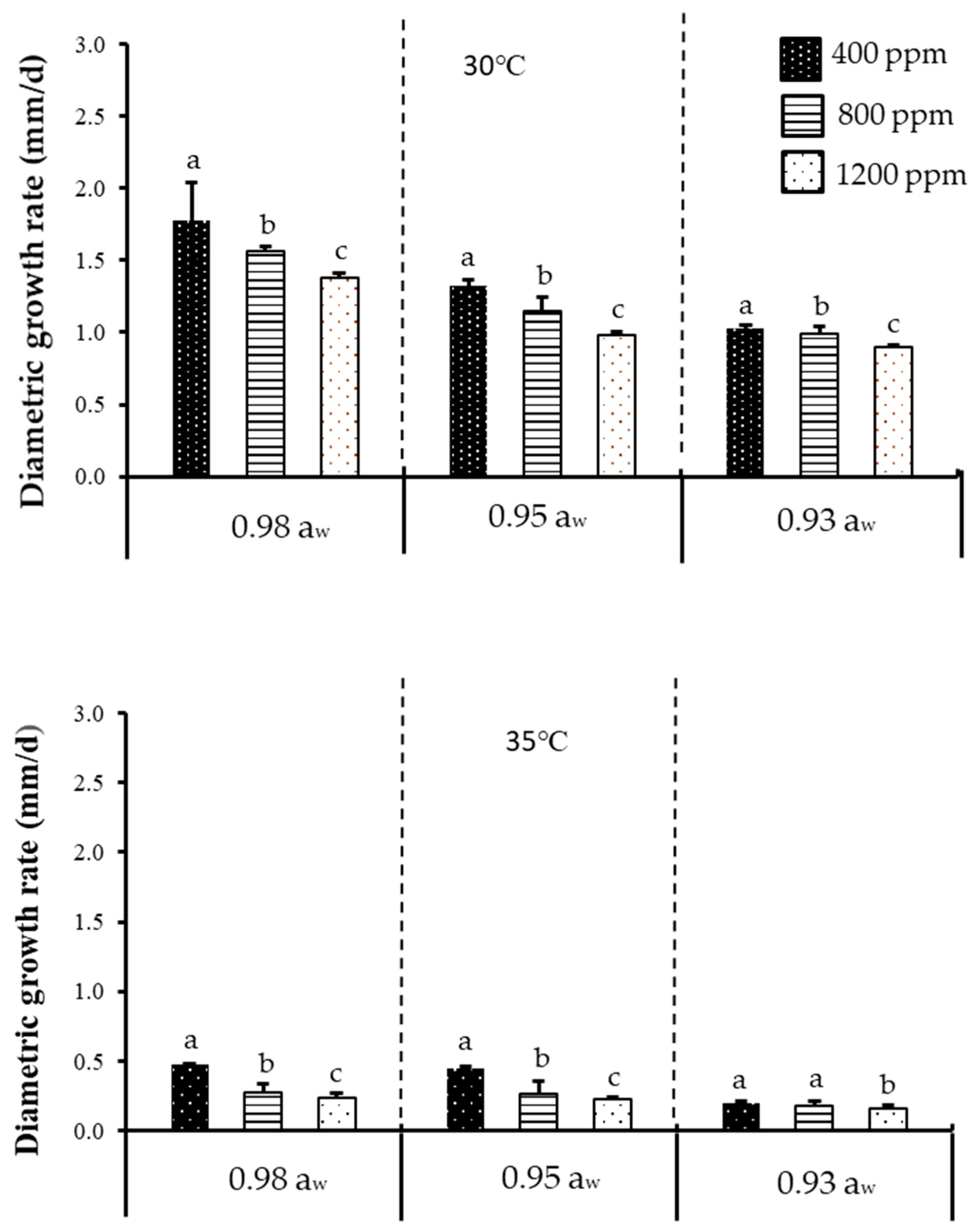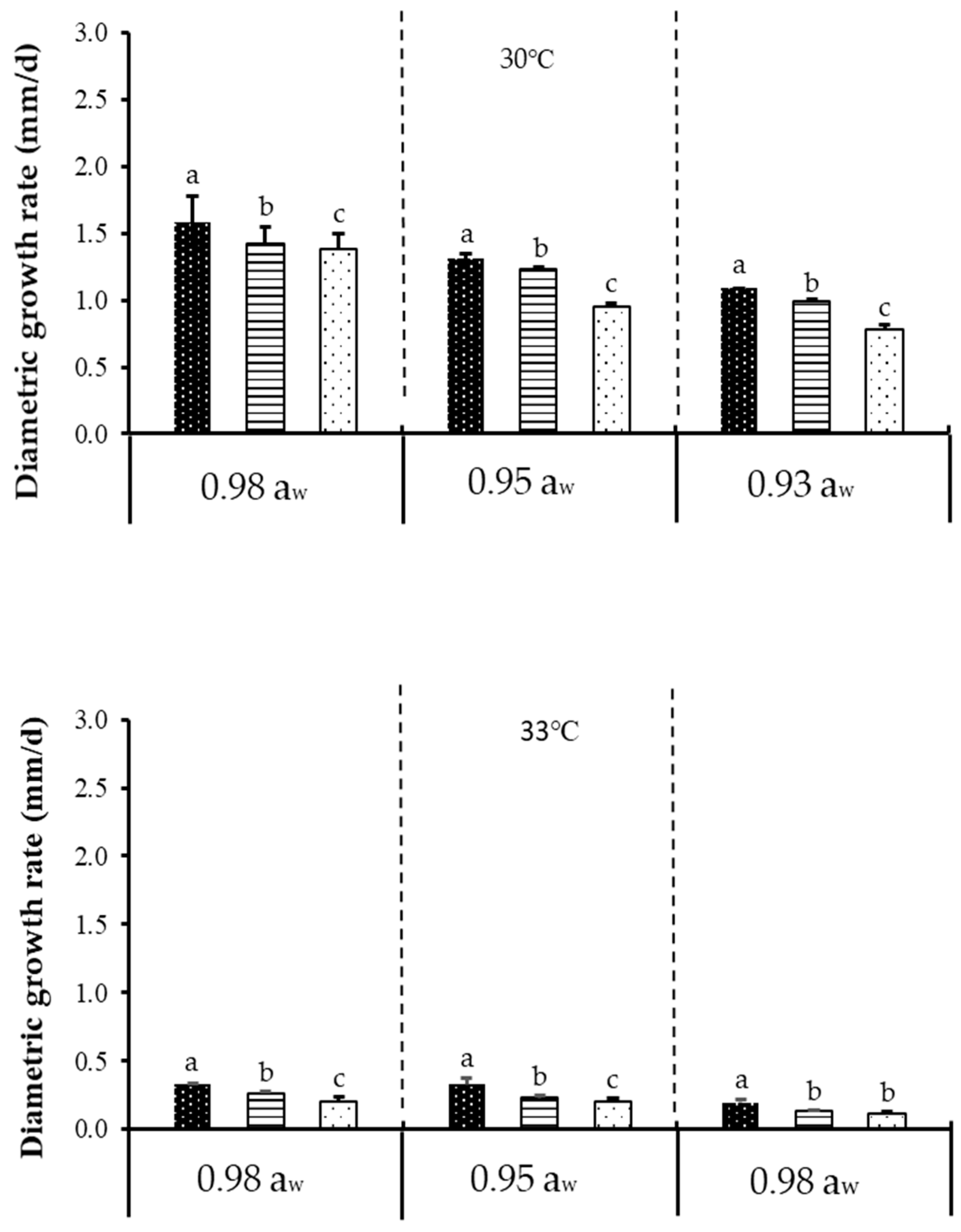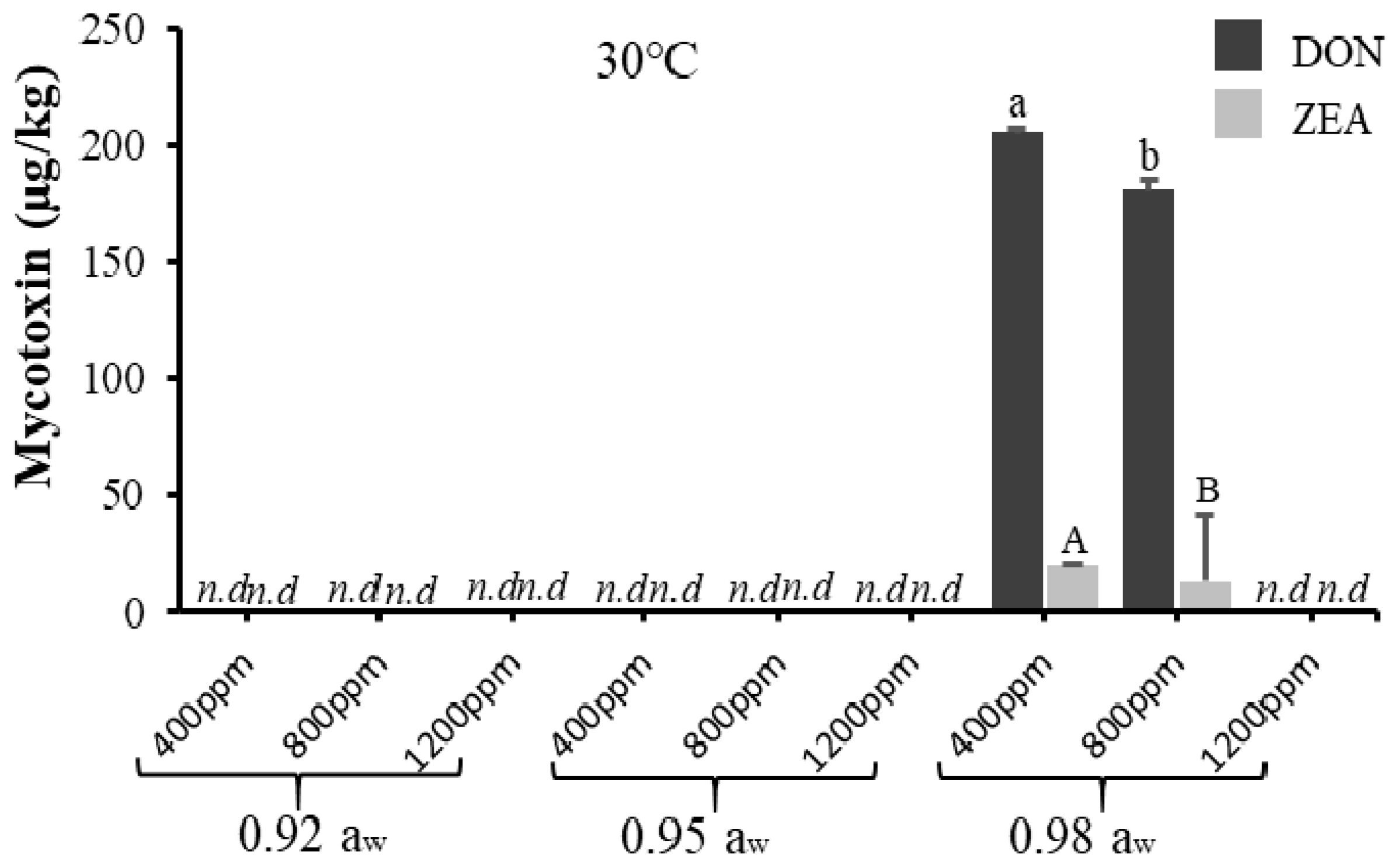Effect of Temperature, Water Activity and Carbon Dioxide on Fungal Growth and Mycotoxin Production of Acclimatised Isolates of Fusarium verticillioides and F. graminearum
Abstract
1. Introduction
2. Results and Discussion
2.1. Effect of Simulated Climate Change Conditions on Diametric Growth Rates of Acclimatised Isolates of F. verticillioides and F. graminearum
2.2. Effect of Simulated Climate Change Conditions on Mycotoxin Production of Acclimatised Isolates of F. verticillioides and F. graminearum
3. Conclusions
4. Materials and Methods
4.1. Fungal Isolates, Materials, Chemicals and Standards
4.2. Semi-Synthetic Growth Medium Preparation
4.3. Fungal Acclimatisation
4.4. Experimental Design
4.5. Fungal Inoculation on Milled-Maize Agar
4.6. Fungal Incubation in Simulated Climate Change Conditions
4.7. Measurement of Fungal Growth by Diametric Growth Rate
4.8. Measurement of Mycotoxin Production by UHPLC/QTOF-MS
4.9. Statistical Analysis
Author Contributions
Funding
Acknowledgments
Conflicts of Interest
References
- Giorni, P.; Bertuzzi, T.; Battilani, P. Impact of fungi co-occurrence on mycotoxin contamination in maize during the growing season. Front. Microbiol. 2019, 10, 1265. [Google Scholar] [CrossRef]
- Geary, P.A.; Chen, G.; Kimanya, M.E.; Shirima, C.P.; Oplatowska-Stachowiak, M.; Elliott, C.T.; Routledge, M.N.; Yun, Y. Determination of multi-mycotoxin occurrence in maize based porridges from selected regions of Tanzania by liquid chromatography—Tandem mass spectrometry (LC-MS/MS), a longitudinal study. Food Control 2016, 68, 337–343. [Google Scholar] [CrossRef]
- Bankole, S.A.; Mabekoje, O.O. Occurrence of aflatoxins and fumonisins in preharvest maize from south-western Nigeria. Food Addit. Contam. 2004, 21, 251–255. [Google Scholar] [CrossRef]
- Kimanya, M.E.; De Meulenaer, B.; Tiisekwa, B.; Ndomondo-Sigonda, M.; Devlieghere, F.; Van Camp, J.; Kolsteren, P. Co-occurrence of fumonisins with aflatoxins in home-stored maize for human consumption in rural villages of Tanzania. Food Addit. Contam. 2008, 25, 1353–1364. [Google Scholar] [CrossRef] [PubMed]
- Picot, A.; Hourcade-Marcolla, D.; Barreau, C.; Pinson-Gadais, L.; Caron, D.; Richard-Forget, F.; Lannou, C. Interactions between Fusarium verticillioides and Fusarium graminearum in maize ears and consequences for fungal development and mycotoxin accumulation. Plant Pathol. 2012, 61, 140–151. [Google Scholar] [CrossRef]
- Mazumder, P.M.; Sasmal, D. Mycotoxins–limits and regulations. Anc. Sci. Life 2001, 20, 1–19. [Google Scholar]
- Ostry, V.; Malir, F.; Toman, J.; Grosse, Y. Mycotoxins as human carcinogens—The IARC Monographs classification. Mycotoxin Res. 2017, 33, 65–73. [Google Scholar] [CrossRef] [PubMed]
- Lahouar, A.; Crespo-Sempere, A.; Marín, S.; Saïd, S.; Sanchis, V. Toxigenic moulds in Tunisian and Egyptian sorghum for human consumption. J. Stored Prod. Res. 2015, 63, 57–62. [Google Scholar] [CrossRef]
- Moretti, A.; Pascale, M.; Logrieco, A.F. Mycotoxin risks under a climate change scenario in Europe. Trends Food Sci. Technol. 2019, 84, 38–40. [Google Scholar] [CrossRef]
- Paterson, R.R.M.; Lima, N. How will climate change affect mycotoxins in food? Food Res. Int. 2010, 43, 1902–1914. [Google Scholar] [CrossRef]
- Battilani, P.; Toscano, P.; Van Der Fels-Klerx, H.J.; Moretti, A.; Camardo, L.M.; Brera, C.; Rortais, A.; Goumperis, T.; Robinson, T. Aflatoxin B1 contamination in maize in Europe increases due to climate change. Sci. Rep. 2016, 6, 1–7. [Google Scholar] [CrossRef] [PubMed]
- Magan, N.; Medina, A.; Aldred, D. Possible climate-change effects on mycotoxin contamination of food crops pre- and postharvest. Plant Pathol. 2011, 60, 150–163. [Google Scholar] [CrossRef]
- Medina, Á.; González-Jartín, J.M.; Sainz, M.J. Impact of global warming on mycotoxins. Curr. Opin. Food Sci. 2017, 18, 76–81. [Google Scholar] [CrossRef]
- Nda, M.; Adnan, M.S.; Ahmad, K.A.; Usman, N.; Razi, M.A.M.; Daud, Z. A review on the causes, effects and mitigation of climate changes on the environmental aspects. Int. J. Integr. Eng. 2018, 10, 169–175. [Google Scholar] [CrossRef]
- Samapundo, S.; De Meulenaer, B.; Atukwase, A.; Debevere, J.; Devlieghere, F. The influence of modified atmospheres and their interaction with water activity on the radial growth and fumonisin B1 production of Fusarium verticillioides and F. proliferatum on corn. Part I: The effect of initial headspace concentration. Int. J. Food Microbiol. 2007, 114, 160–167. [Google Scholar] [CrossRef]
- Akbar, A.; Medina, A.; Magan, N. Impact of interacting climate change factors on growth and ochratoxin A production by Aspergillus section Circumdati and Nigri species on coffee. World Mycotoxin J. 2016, 9, 863–874. [Google Scholar] [CrossRef]
- Luck, J.; Spackman, M.; Freeman, A.; Trebicki, P.; Griffiths, W.; Finlay, K.; Chakraborty, S. Climate change and diseases of food crops. Plant Pathol. 2011, 60, 113–121. [Google Scholar] [CrossRef]
- Medina, A.; Akbar, A.; Baazeem, A.; Rodriguez, A.; Magan, N. Climate change, food security and mycotoxins: Do we know enough? Fungal Biol. Rev. 2017, 31, 143–154. [Google Scholar] [CrossRef]
- Medina, Á.; Rodríguez, A.; Magan, N. Climate change and mycotoxigenic fungi: Impacts on mycotoxin production. Curr. Opin. Food Sci. 2015, 5, 99–104. [Google Scholar] [CrossRef]
- Medina, A.; Schmidt-heydt, M.; Cárdenas-Chávez, D.L.; Parra, R.; Geisen, R.; Magan, N. Integrating toxin gene expression, growth and fumonisin B1 and B2 production by a strain of Fusarium verticillioides under different environmental factors. J. R. Soc. Interface 2013, 10, 20130320. [Google Scholar] [CrossRef]
- Torres, M.R.; Ramos, A.J.; Soler, J.; Sanchis, V.; Marín, S. SEM study of water activity and temperature effects on the initial growth of Aspergillus ochraceus, Alternaria alternata and Fusarium verticillioides on maize grain. Int. J. Food Microbiol. 2003, 81, 185–193. [Google Scholar] [CrossRef]
- Schmidt-Heydt, M.; Parra, R.; Geisen, R.; Magan, N. Modelling the relationship between environmental factors, transcriptional genes and deoxynivalenol mycotoxin production by strains of two Fusarium species. J. R. Soc. Interface 2010, 8, 117–126. [Google Scholar] [CrossRef] [PubMed]
- Velluti, A.; Marin, S.; Bbettucci, L.; Ramos, A.J.; Sanchis, V. The effect of fungal competition on colonization of maize grain by Fusarium moniliforme, F. proliferatum and F. graminearum and on fumonisin B1 and zearalenone formation. Int. J. Food Microbiol. 2000, 59, 59–66. [Google Scholar] [CrossRef]
- Váry, Z.; Mullins, E.; Mcelwain, J.C.; Doohan, F.M. The severity of wheat diseases increases when plants and pathogens are acclimatized to elevated carbon dioxide. Glob. Chang. Biol. 2015, 21, 2661–2669. [Google Scholar] [CrossRef] [PubMed]
- Paterson, R.R.M.; Lima, N.; Taniwaki, M.H. Coffee, mycotoxins and climate change. Food Res. Int. 2014, 61, 1–15. [Google Scholar] [CrossRef]
- Magan, N.; Aldred, D. Post-harvest control strategies: Minimizing mycotoxins in the food chain. Int. J. Food Microbiol. 2007, 119, 131–139. [Google Scholar] [CrossRef]
- Hope, R.; Aldred, D.; Magan, N. Comparison of environmental profiles for growth and deoxynivalenol production by Fusarium culmorum and F. graminearum on wheat grain. Lett. Appl. Microbiol. 2005, 40, 295–300. [Google Scholar] [CrossRef]
- Manstretta, V.; Rossi, V. Effects of temperature and moisture on development of Fusarium graminearum perithecia in maize stalk residues. Appl. Environ. Microbiol. 2016, 82, 184–191. [Google Scholar] [CrossRef]
- Miller, J.D. Mycotoxins in small grains and maize: Old problems, new challenges. Food Addit. Contam. 2008, 25, 219–230. [Google Scholar] [CrossRef]
- Xu, X.M.; Parry, D.W.; Nicholson, P.; Thomsett, M.A.; Simpson, D.; Edwards, S.G.; Cooke, B.M.; Doohan, F.M.; Brennan, J.M.; Moretti, A.; et al. Predominance and association of pathogenic fungi causing Fusarium ear blight in wheat in four European countries. Eur. J. Plant Pathol. 2005, 112, 143–154. [Google Scholar] [CrossRef]
- Pasquali, M.; Beyer, M.; Logrieco, A.; Audenaert, K.; Balmas, V.; Basler, R.; Boutigny, A.L.; Chrpová, J.; Czembor, E.; Gagkaeva, T.; et al. A European Database of Fusarium graminearum and F. culmorum Trichothecene Genotypes Front. Front. Microbiol. 2017, 7, 406. [Google Scholar]
- Malaysian Department of Meteorology. Available online: http://www.met.gov.my/ (accessed on 24 March 2019).
- Panwar, V.; Aggarwal, A.; Paul, S.; Singh, V.; Singh, P.K.; Sharma, D.; Shaharan, M.S. Effect of temperature and pH on the growth of Fusarium spp. causing Fusarium head blight (FHB) in wheat. South Asian J. Exp. Biol. 2016, 6, 186–193. [Google Scholar]
- Etcheverry, M.; Torres, A.; Ramirez, M.L.; Chulze, S.; Magan, N. In vitro control of growth and fumonisin production by Fusarium verticillioides and F. proliferatum using antioxidants under different water availability and temperature regimes. J. Appl. Microbiol. 2001, 92, 624–632. [Google Scholar] [CrossRef]
- Samapundo, S.; Devlieghere, F.; de Meulenaer, B.; Geeraerd, A.H.; van Impe, J.F.; Debevere, J.M. Predictive modelling of the individual and combined effect of water activity and temperature on the radial growth of Fusarium verticilliodes and F. proliferatum on corn. Int. J. Food Microbiol. 2005, 105, 35–52. [Google Scholar] [CrossRef]
- Marín, S.; Homedes, V.; Sanchis, V.; Ramos, A.J.; Magan, N. Impact of Fusarium moniliforme and F. proliferatum colonisation of maize on calorific losses and fumonisin production under different environmental conditions. J. Stored Prod. Res. 1999, 35, 15–26. [Google Scholar] [CrossRef]
- Vesonder, R.F.; Ellis, J.J.; Kwolek, W.F.; De Marini, D. Production of vomitoxin on corn by Fusarium graminearum NRRL 5883 and Fusarium roseum NRRL 6101. Appl. Environ. Microbiol. 1982, 43, 967–970. [Google Scholar] [CrossRef] [PubMed]
- Marín, S.; Magan, N.; Ramos, A.J.; Sanchis, V. Fumonisin-producing strains of Fusarium: A review of their ecophysiology. J. Food Prot. 2004, 67, 1792–1805. [Google Scholar] [CrossRef] [PubMed]
- Yazid, S.N.E.; Thanggavelu, H.; Mahror, N.; Selamat, J.; Samsudin, N.I.P. Formulation of maize- and peanut-based semi-synthetic growth media for the ecophysiological studies of aflatoxigenic Aspergillus flavus in maize and peanut agro-ecosystems. Int. J. Food Microbiol. 2018, 282, 57–65. [Google Scholar] [CrossRef]
- Dallyn, H.; Fox, A. Microbial Growth and Survival in Extremes of Environment. In Society for Applied Bacteriology Technical Series; no 15; Academic Press: London, UK, 1980. [Google Scholar]
- Lahouar, A.; Marín, S.; Crespo-Sempere, A.; Saïd, S.; Sanchis, V. Influence of temperature, water activity and incubation time on fungal growth and production of ochratoxin A and zearalenone by toxigenic Aspergillus tubingensis and Fusarium incarnatum isolates in sorghum seeds. Int. J. Food Microbiol. 2017, 242, 53–60. [Google Scholar] [CrossRef] [PubMed]
- Passamani, F.R.F.; Hernandes, T.; Lopes, N.A.; Bastos, S.C.; Santiago, W.D.; Cardoso, M.D.G.; Batista, L.R. Effect of temperature, water activity, and pH on growth and production of ochratoxin A by Aspergillus niger and Aspergillus carbonarius from Brazilian grapes. J. Food Prot. 2014, 77, 1947. [Google Scholar] [CrossRef]
- Medina, A.; Rodríguez, A.; Sultan, Y.; Magan, N. Climate change factors and Aspergillus flavus: Effects on gene expression, growth and aflatoxin production. World Mycotoxin J. 2015, 8, 171–179. [Google Scholar] [CrossRef]
- ESRL. Trends in Atmospheric Carbon Dioxide. Earth System Research Laboratory, Global Monitoring Divivon, National Oceanic and Atmospheric Administration. 2020. Available online: http://www.esrl.noaa.gov/gmd/ccgg/trends/global.html (accessed on 22 February 2020).
- Lazzaro, I.; Susca, A.; Mulè, G.; Ritieni, A.; Ferracane, R.; Marocco, A.; Battilani, P. Effects of temperature and water activity on FUM2 and FUM21 gene expression and fumonisin B production in Fusarium verticillioides. Eur. J. Plant Pathol. 2012, 1234, 685–695. [Google Scholar] [CrossRef]
- Mogensen, J.M.; Nielsen, K.F.; Samson, R.A.; Frisvad, J.C.; Thrane, U. Effect of temperature and water activity on the production of fumonisins by Aspergillus niger and different Fusarium species. BMC Microbiol. 2009, 9, 281. [Google Scholar] [CrossRef] [PubMed]
- Samsudin, N.I.P.; Magan, N. Efficacy of potential biocontrol agents for control of Fusarium verticillioides and fumonisin B1 under different environmental conditions. World Mycotoxin J. 2016, 9, 205–213. [Google Scholar] [CrossRef]
- Leggieri, C.M.; Giorni, P.; Pietri, A.; Battilani, P. Aspergillus flavus and Fusarium verticillioides Interaction: Modeling the impact on mycotoxin production. Front. Microbiol. 2019, 10, 1–10. [Google Scholar]
- Duverger, F.; Bailly, S.; Querin, A.; Pinson-Gadais, L.; Guerre, P.; Bailly, J.D. Influence of culture medium and incubation time on the simultaneous synthesis of deoxynivalenol and zearalenone by Fusarium graminearum. Revenue Med. Vet. 2011, 162, 93–97. [Google Scholar]
- Bragulat, M.R.; Abarca, M.L.; Cabañes, F.J. An easy screening method for fungi producing ochratoxin A in pure culture. Int. J. Food Microbiol. 2001, 71, 139–144. [Google Scholar] [CrossRef]
- Ren, G.; Hu, Y.; Zhang, J.; Zou, L.; Zhao, G. Determination of multi-class mycotoxins in Tartary buckwheat by ultra-fast liquid chromatography coupled with triple quadrupole mass spectrometry. Toxins 2018, 10, 28. [Google Scholar] [CrossRef] [PubMed]
- Tanaka, H.; Takino, M.; Sugita-konishi, Y.; Tanaka, T. Development of a liquid chromatography/time-of-flight mass spectrometric method for the simultaneous determination of trichothecenes, zearalenone and aflatoxins in foodstuffs. Rapid Commun. Mass Spectrom. 2006, 20, 1422–1428. [Google Scholar] [CrossRef]




| Source | DF | MS | F-Value |
|---|---|---|---|
| F. verticillioides | |||
| T | 1 | 413.18 | 17,122.91 * |
| aw | 2 | 21.290 | 882.29 * |
| CO2 | 2 | 7.96 | 329.94 * |
| T × aw | 2 | 9.08 | 376.33 * |
| T × CO2 | 2 | 0.66 | 27.74 * |
| aw × CO2 | 4 | 0.84 | 34.99 * |
| T × aw × CO2 | 4 | 0.024 | 0.01 |
| F. graminearum | |||
| T | 1 | 424.181 | 1565.21 * |
| aw | 2 | 14.821 | 54.69 * |
| CO2 | 2 | 5.94 | 21.92 * |
| T × aw | 2 | 6.13 | 0.55 |
| T × CO2 | 2 | 1.42 | 22.65 * |
| aw × CO2 | 4 | 0.14 | 0.55 |
| T × aw × CO2 | 4 | 0.27 | 0.14 |
| Source | DF | MS | F-Value |
|---|---|---|---|
| FB1 | |||
| T | 1 | 7643.85 | 31.39 * |
| aw | 2 | 2050.18 | 8.42 * |
| CO2 | 2 | 514.15 | 2.11 |
| T × aw | 2 | 2884.51 | 11.85 * |
| T × CO2 | 2 | 771.11 | 3.17 |
| aw × CO2 | 4 | 1451.5 | 1.24 |
| T × aw × CO2 | 4 | 302.65 | 1.06 |
| FB2 | |||
| T | 1 | 126.48 | 5.05 |
| aw | 2 | 198.74 | 7.94 * |
| CO2 | 2 | 52.16 | 2.08 |
| T × aw | 2 | 174.51 | 6.97 |
| T × CO2 | 2 | 84.09 | 3.36 |
| aw × CO2 | 4 | 96.42 | 2.25 |
| T × aw × CO2 | 4 | 46.34 | 0.64 |
| Source | DF | MS | F-Value |
|---|---|---|---|
| DON | |||
| T | 1 | 6015.16 | 4.17 |
| aw | 2 | 9416.85 | 6.53 * |
| CO2 | 2 | 2993.66 | 2.07 |
| T × aw | 2 | 8829.29 | 6.12 |
| T × CO2 | 2 | 3412.61 | 2.36 |
| aw × CO2 | 4 | 2341.51 | 1.62 |
| T × aw × CO2 | 4 | 2376.36 | 1.68 |
| ZEA | |||
| T | 1 | 41.44 | 3.10 |
| aw | 2 | 61.93 | 4.86 * |
| CO2 | 2 | 23.86 | 1.79 |
| T × aw | 2 | 63.51 | 4.75 |
| T × CO2 | 2 | 24.47 | 1.83 |
| aw × CO2 | 4 | 20.67 | 1.33 |
| T × aw × CO2 | 4 | 17.76 | 0.80 |
© 2020 by the authors. Licensee MDPI, Basel, Switzerland. This article is an open access article distributed under the terms and conditions of the Creative Commons Attribution (CC BY) license (http://creativecommons.org/licenses/by/4.0/).
Share and Cite
Peter Mshelia, L.; Selamat, J.; Iskandar Putra Samsudin, N.; Rafii, M.Y.; Abdul Mutalib, N.-A.; Nordin, N.; Berthiller, F. Effect of Temperature, Water Activity and Carbon Dioxide on Fungal Growth and Mycotoxin Production of Acclimatised Isolates of Fusarium verticillioides and F. graminearum. Toxins 2020, 12, 478. https://doi.org/10.3390/toxins12080478
Peter Mshelia L, Selamat J, Iskandar Putra Samsudin N, Rafii MY, Abdul Mutalib N-A, Nordin N, Berthiller F. Effect of Temperature, Water Activity and Carbon Dioxide on Fungal Growth and Mycotoxin Production of Acclimatised Isolates of Fusarium verticillioides and F. graminearum. Toxins. 2020; 12(8):478. https://doi.org/10.3390/toxins12080478
Chicago/Turabian StylePeter Mshelia, Ladi, Jinap Selamat, Nik Iskandar Putra Samsudin, Mohd Y. Rafii, Noor-Azira Abdul Mutalib, Noordiana Nordin, and Franz Berthiller. 2020. "Effect of Temperature, Water Activity and Carbon Dioxide on Fungal Growth and Mycotoxin Production of Acclimatised Isolates of Fusarium verticillioides and F. graminearum" Toxins 12, no. 8: 478. https://doi.org/10.3390/toxins12080478
APA StylePeter Mshelia, L., Selamat, J., Iskandar Putra Samsudin, N., Rafii, M. Y., Abdul Mutalib, N.-A., Nordin, N., & Berthiller, F. (2020). Effect of Temperature, Water Activity and Carbon Dioxide on Fungal Growth and Mycotoxin Production of Acclimatised Isolates of Fusarium verticillioides and F. graminearum. Toxins, 12(8), 478. https://doi.org/10.3390/toxins12080478





